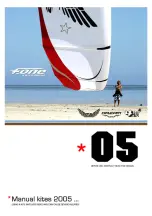
CUMEO
PACKING
Conscientiously packing your glider guarantees a consistently high quality.
First, remove all leaves, grass, sand, etc., then sort the lines and lay them on top of the
glider. Always make sure that the glider is dry and clean before you pack it.
Start with the second cell from the middle and lay them cell for cell on top of each other
so that the reinforcements of the inlets are kept together. Repeat this process on the
trailing edge by starting from the middle and folding together every second panel, drawing
them towards the middle. After that, lay the folded panels on top of each other and press
the air from the trailing to the leading edge. After doing this on both sides, turn one half
onto the other and beginning from the bottom, fold the glider up towards the leading edge.
You can fold the risers in with the glider or leave them sticking out at the bottom or still
attached to your harness. When packing, remember to straighten out the lines and shack-
les to keep them from bending. After every fold, let out the remaining air in the glider
through the leading edge. Attach the compression strap around the glider loosely and
place it in the nylon bag. If you prefer to use a tube, the steps are the same up the point
where you turn the folded panels onto each other. Pull the straps tight and make sure that
no material is caught in the zippers.
You can also pack any skywalk glider with elastic nylon wires by any other method without
damaging the leading edge. Place the harness with the seat board facing up (to distribute
the load better) on top of your glider and close the zippers.
You will find adequate space rest of your equipment (helmet, overall, instruments, etc.)
under the cover of the rucksack.
A hint to increase the life of your glider even more:
Don’t pack your glider too tightly. Treat the leading edge with care despite its robustness
and open up your wing a bit if you store it for a longer period of time.
WINCHTOWING
The skywalk CUMEO is well suited for winch towing. Make sure that you only use certified
winches and that you climb from the ground at a flat angle.
The pilot must have had proper towing instruction and must ensure that the winch opera-
tor has had proper training that includes paragliders. When launching on a winch, always
fly with a lot of feeling and don’t brake too much as your glider will already have an in-
creased angle of attack. We recommend the use of a towing adapter.
FLYING WITH A MOTOR
Currently, the CUMEO has no certification for flying with a motor.
You can find out the current status of motor certification at any dealer or importer, or by
asking skywalk directly.
6 DESCENT TECHNIQUES
This manual is not intended to be an instruction manual and skywalk highly recommends
taking part in a safety training course over water.
The following hints will help you to get the most out of your glider.
For all extreme maneuvers it is important:
> First to practice them under the tutelage of a certified flight instructor as part
of a safety training course.
> To ensure that the airspace below you is clear before entering each maneuver.
> To maintain eye contact with your glider throughout each maneuver.
SPIRAL DIVE
The skywalk CUMEO does not tend to enter a stable spiral dive – rather, it will recover
by itself if the brakes are released. You can enter a spiral dive by carefully increasing the
brake pressure on the inside of a turn while shifting your weight in the same direction.
If the glider doesn’t bank enough and the sink rate doesn’t increase, it’s better to start
over again rather than to keep applying brake without sensitivity. The spiral begins when
the glider banks sharply to the side and enters a sharp, steep turn. You can control the
bank angle and descent rate by applying or releasing the inside brake.
The spiral dive can be used to lose altitude quickly, so please
consider the following:
> High sink rates and the related high G-forces lead to a high physical strain on the body
that may be too much for inexperienced pilots! Approach spiral dives slowly!
> Tensing your stomach muscles during a spiral dive can be very helpful!
> If you feel dizzy or faint, exit the spiral dive immediately!
> Due to the extreme altitude loss in a spiral dive, make sure you always have
enough safe reserve.
> To avoid strong surging when exiting the spiral dive, release the inside brake slowly
while continuing to apply the outside brake.
> The brake line pressure in a spiral dive is substantially higher than in normal flight!
Descent Techniques
45
44
Flight Techniques and Characteristics
EN


































